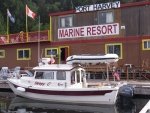Wood Zeppelin
Member
- Joined
- Feb 9, 2016
- Messages
- 362
- Reaction score
- 0
- C Dory Year
- 1997
- C Dory Model
- 22 Angler
- Vessel Name
- C-Creature
Spotted a deadhead off Ediz Hook (Port Angeles) this weekend. At first it looked like some kind of Bouy. It was bobbing slowly in the waves/swell, and would sometimes disappear underwater momentarily.
I'm curious:
(1) Does anyone know where they come from and how they end up suspended perfectly vertical in the water column?
(2) If you are running at times of low light, how would you avoid them?
(3) Are they more common in the Strait than Puget Sound? How about the Salish Sea in general, are they in certain areas?
(4) what if we all carried orange flags in our boats that could quickly/easily be mounted on top of a deadhead to mark them so others are less likely to crash into them?
(5) Anyone here ever hit one? What happened?
I'm curious:
(1) Does anyone know where they come from and how they end up suspended perfectly vertical in the water column?
(2) If you are running at times of low light, how would you avoid them?
(3) Are they more common in the Strait than Puget Sound? How about the Salish Sea in general, are they in certain areas?
(4) what if we all carried orange flags in our boats that could quickly/easily be mounted on top of a deadhead to mark them so others are less likely to crash into them?
(5) Anyone here ever hit one? What happened?

